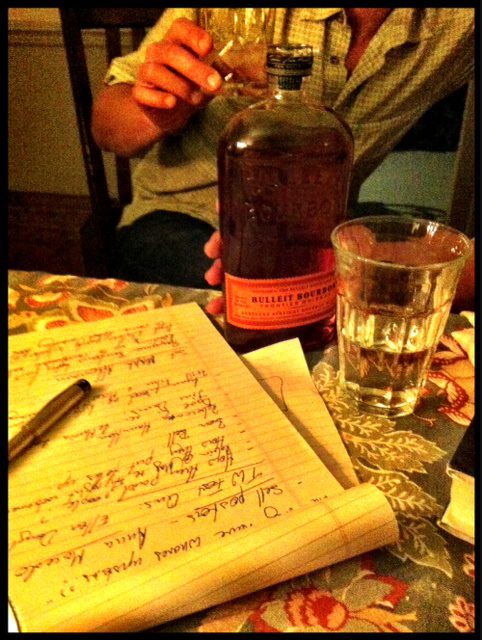View From Your Table

I shot this at a planning committee meeting of the Walker Percy Weekend festival, in my house tonight. The most important resolutions: 1) we are going to have a progressive front porch bourbon tasting along Royal Street, and 2) we are going to try to get Phil Donahue to come to town to do a real-life “Last Phil Donahue Show” from Lost In The Cosmos.
Any of you readers know Phil Donahue? Let me know how to get in touch with him. Gang, this is going to be a very, very fun festival. Ideas, books, the South, Catholicism, beer, crawfish, bourbon — how can you possibly go wrong?
Have to tell you that for dinner tonight, I made a fricasseed chicken in a red wine vinegar, herbs, and cream sauce, from the great book The Auberge Of The Flowering Hearth. It was such an easy recipe I probably have it committed to memory after only making it once … but man, was it ever something special.
UPDATE: Okay, okay, here’s an adaptation of the recipe from Auberge, a book that you really should own if you care at all about cooking:
FRICANDEAU OF CHICKEN IN RED WINE VINEGAR
(Fricandeau de Poulet au Vinaigre de Vin Rouge)
Unsalted butter (6 tbsp)
Garlic, unpeeled (4 cloves)
Tomato paste (2 tbsp)
Red wine vinegar (about 1 1/2 cups)
Roasting chicken, cut up for fricassee (about 3 1/2 lbs)
Clear chicken broth (2 cups)
Good strong veal broth, or demi-glace (1/2 cup) [Note: I didn’t have this; I substituted a strong chicken broth made from concentrate — RD]
Heavy cream (3/4 cup)
Chives (small bunch)
Parsley (small bunch)
Fresh tarragon leaves, if available (small bunch); dried tarragon (1 tsp) if necessary
Thyme
Salt and pepper
This dish is entirely prepared in a sauté pan with a well-fitting lid and large enough to hold all the chicken pieces, with some extra room to be able to move the pieces around easily. If you first dry the chicken pieces, they will brown better. Rub the chicken pieces with salt and pepper. Set the sauté pan over medium-high frying heat and quickly melt in it 4 tbsp of the butter. Then put in the chicken pieces and quickly sauté them to a good, deep brown. As soon as the chicken begins to brown, put in the 4 unpeeled cloves of garlic. This is the secret trick, since, if the garlic is peeled, if will burn and give a bitter flavor to the sauce. Also, do not be afraid of the large amount of garlic. By frying it with the chicken, much of its oil is evaporated and the end result is about equal to 1 clove. Stir the garlic cloves around and see to it that their skins become lightly browned and crisp. Also add to the pan 3 or 4 sprigs of parsley, about 2 tablespoons of chopped chives, a small handful of fresh tarragon leaves (or 1 teaspoon dried), plus 1 teaspoon dried thyme. Stir everything around for hardly more than a couple of minutes, turning over the chicken pieces to absorb the flavors on all sides. Add more butter if necessary. When the browning is complete, turn down the heat to simmering, put on the lid and let the juices bubble gently for 25 minutes.
Meanwhile, set the over to keep-warm temperature, about 175 degrees, and heat up a covered bowl for the chicken pieces. When the chicken has finished bubbling, take them out of the pan and keep them warm in the bowl, covered, in the oven. Turn up the heat under the saute pan and hiss into it 3/4 cup of the red wine vinegar, vigorously scraping and deglazing the bottom of the pan. Add the 2 cups chicken broth, the 1/2 cup of veal broth or demi-glace, and the 2 tablespoons of tomato paste. Let it all boil hard, stirring often, to reduce and concentrate flavors. Taste the sauce as it reduces. When the nip of the vinegar has changed from mouth-puckering to agreeably zinging in the back of the mouth and throat, the sauce is ready. [Note from Rod: This is really important! You’ll know when the sauce is ready only by tasting it frequently — RD]
Strain it, and put it back into the pan. If it now has enough garlic flavor for your taste, discard the garlic cloves from the strainer. But if you like it a little more garlicky, squeeze the soft garlic mash from the cloves into the sauce, and discard the husks. Work into the sauce the 3/4 cup of heavy cream — and from this point on, keep the sauce always just below boiling, or it may curdle. [Note from Rod: This is important too; yesterday, I turned away from the pan for a few seconds, and turned back just as it was starting to boil. Had I let it continue, or looked away for a few more seconds, the cream might have curdled, ruining the sauce.]
Check and adjust the seasonings, adding more vinegar and/or more tomato paste until you have it just right, as you like. Put the chicken pieces back into this sauce, letting them warm up in it and absorb its flavors, covered, for about 10 minutes. Make sure that the sauce does not boil! Serve on a hot platter, with the sauce poured over and chopped fresh leaves of chervil, parsley, and tarragon (if you have any of this) sprinkled on top.
Good homemade white bread, or a baguette, or sliced sourdough, is the best thing to soak up the sauce. Alternatively, white rice would go well with this. As for wine, nothing is better with this dish than a bright, crisp, dry rosé.

Subscribe for as little as $5/mo to start commenting on Rod’s blog.